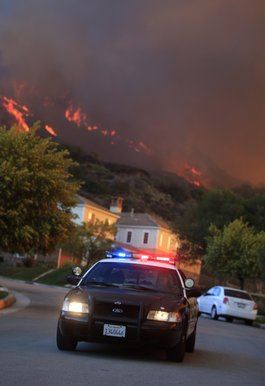What lies beneath after the smoke clears from a fire? …Ash, Soot, and Smoke Damage!
In some cases, entire communities are evacuated. Such was the case in the recent 1000-Acre brush fire in Etiwanda, California that called for a mandatory evacuation of 1650 homes. Though it is often NOT the risk of burning that is of most concern; but the extent and devastation of smoke, soot, and ash damage.
The damage that results from most types of fire, is most often a consequence of Ash, Soot and Smoke Damage. Smoke  is a complex mixture of Solids e.g.
is a complex mixture of Solids e.g.
Dust particles; Liquids i.e., water and gaseous compounds like organic acids, poly nuclear aromatic hydrocarbons (PAHs), volatile and semi volatile organic compounds.
It should be noted that the types of particles, gases and liquid compounds that make up smoke largely depends on the type and amount of Fuel in play. When it comes to wildfires, the fuel is plant material.
Smoke and Soot is categorized and classified by its sources:
• Natural, (wood & paper)
• Synthetic, (plastics, vinyl and most carpeting)
• Enzyme (burnt plants or meats)
Each category requires its own methods of smoke damage and fire damage remediation.
It is rather disturbing to note that each of the components that make up the mixture we call smoke; are in and of them very harmful.
The combined effect if often deleterious to life and property as a whole on a short term and long term scale.
Kristen Shaw of Clark Seif Clark, Inc., notes for example, that “several PAHs in wildfire smoke, such as benzo(a)pyrene, benz(a)anthracene/
chrysene and benzo(j)oranthenes are carcinogenic. Organic acids such as 2-furaldehyde and vinyl acetate are not only carcinogenic, but can
cause property damage by corroding susceptible surfaces.”
Particulate matter (PM) is another component of smoke with debilitating effects. These particulate are both organic and inorganic e.g. plastics as a result of littering. Scientific data has well established a correlation between an increase in the concentration of particulate matter; and the incidence of respiratory and cardiovascular disease deaths.
The issue of PM is particularly disturbing because of the manner in which these particulates are sized.
Wildfires tend to result in fine and ultra-fine particles, that are airborne and therefore breathable.
We all have experienced the “tickle in the throat” after inhaling smoke! These particulates being rather fine can cross any barrier such as windows and doors. Commercial businesses and Industrial facilities tend to draw outdoor air indoors via HVAC. HVAC filters however, are ill-equipped to filter these fine particles.
So what is so disconcerting about these particulates?
The biggest health threat from smoke comes from breathing in fine particles, according to the California EPA. Wildfires produce up to 36 tons of particulate matter per minute. That is the size of one regular humpback whale per minute in fine particulate matter output. In an hour that is 60 humpback whales each 36 tons! That is a lot of toxicity.
Chronic exposure can lead to allergies, bronchitis, and emphysema, while acute exposure can cause impaired judgment, eye and respiratory irritation, and even death. In addition, some gases commonly released in burning, such as methane, and ethylene, have been shown to be carcinogenic in tests on laboratory animals.
In a news article in the Los Angeles Times, October 23, 2007, Michael Kleinman, professor of community and environmental medicine at the University of California, Irvine said: “The very small particles are the ones that can penetrate deeper in the lungs and have harsher health effects.” “Particles, when deposited in the lungs, can cause tissue damage, inflammation and irritation. They can also penetrate and enter the bloodstream and change the way that blood coagulates, so people at highest risk of stroke have worse problems.”
Smoke makes up to 85% – 98% of the breathable particulate matter produced by wildfires. The rest is soot. Soot makes up roughly 2 to 15% of the rest of the particulates. Because the smoke residue that infiltrates indoors is colorless, it is easy to ignore its life threatening effects.
Many people make the erroneous mistake of looking at soot as a reliable indicator of smoke contamination. But as we have seen soot comprises as little as 2% of smoke contamination.
Dealing With Fire, Smoke and Soot Residue – Getting Smoke and Soot Damage Out
I. Wet Smoke Residues
Wet chemical fire extinguishers used in containing various types fires, include:
Wet Chemicals
Foam Canisters
Water/Water hose
Vaporizing Liquids
Retardant Powders
When combined with water from fire hose, internal sprinkler systems, or ash from smoldering fires with low heat, residues are commonly smeary with pungent smoke and musty odor, and usually require thorough wet cleaning to be removed.
II. Dry Smoke Residues
These are the easiest to remove. Result from fast burning, higher temperature fires such as wood fires or furnace puff back. Residues are often dry, powdery, small, non-smeary smoke particles. Dry smoke residues necessitate a dry cleaning process before wet cleaning.
III. Oily Smoke Residues
This residue is resistant to water based cleaning. Result from grease fires, burned plastic, fuel oil furnace back up from heavy nicotine buildup before the fire damage even occurred. This type of soot is resists water based cleaning because of its smeary nature.
Discover what to do after a wildfire here:
https://www.ready.gov/wildfires
Have you suffered Fire Damage or Smoke and Soot Damage?
Smoke and soot damage claims need to be file through a licensed public insurance adjuster and require a test to be performed by a Certified Industrial Hygienist (CIH)
Request A FREE Fire Damage Insurance Claims Review